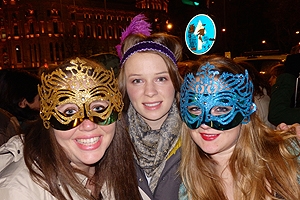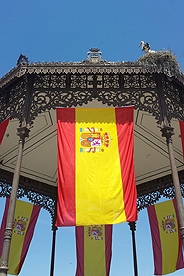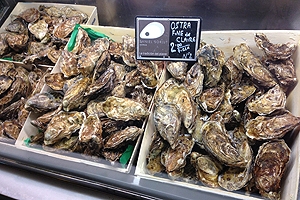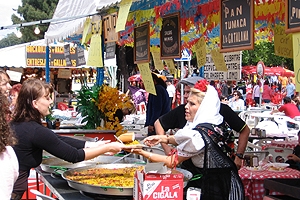
Madrid is the capital of one of the most dynamic countries in Europe. Madrid is the city that never sleeps, full of culture and spirit. Spain as a country has a very unique cultural identity. The Spanish culture is complex, diverse, and quite regional. Each region of Spain like Catalonia, Galicia, the Basque Provinces, and Andalucia has it's own distinct history, dialect, culture, and identity.
The complex history of Spain helped create these unique regions and identities. Rome had control over the Iberian peninsula for approximately 600 years and left a deep mark on the region. Roman ruins can be seen throughout Spain. Afterwards the Visigoths added their influence to the Spanish region and values. The monumental arrival of the Moors in the 8th century and their stay for nearly 800 years had profound influence on Spanish culture and architecture. The Moors fell to the Christians in 1492 and the 16th century came to be referred to as Spain's golden age of discovery and power. The decline of this age in the 18th and 19th century and the civil war in the 1930s further shaped the Spanish identity. Spain is now divided into 17 autonomous regions each with its own special character and personality ripe for exploration by AU students.

You will find that Spaniards in Madrid love to take advantage of their public spaces; parks, avenues, and plazas are frequently bustling with people congregating, enjoying each others company, and truly living within their city. Social life is a priority, though you will find that much of the socializing is done in public spaces rather than in private homes.
Madrid never lacks for things to keep students busy. From world class museums and parks to countless neighborhoods in Madrid and close cities for exciting day trips, there are numerous things to do during free time in Madrid.
Discover Spanish Culture
Language Learning Spanish in Spain

One of the most important things students learn while studying abroad in Spain is how to speak another language. All students will improve their language skills: beginner students will get the basics down and become conversational and more advanced students will fine-tune advanced grammar skills. No matter what, all students will return home much more comfortable and confident in their Spanish language abilities. Keep in mind that Spanish, like English and other languages, has many different variations, dialects, and accents. The Spanish dialect in Spain is Castillian, or Castellano in Spanish: any "z," "ce" or "ci" is pronounced with the English sound "th." For example, gracias (thank you) is pronounced grathias. The Spaniards also use tú (you) and vosotros (you all) with friends and family. Most students who learn Spanish in the USA are not taught the "vosotros" conjugations because they aren't typically used in Latin America. Thus, getting used to hearing and using the vosotros forms of verbs can be an adjustment at the beginning of the semester. By the end of the semester in Madrid, you will have forgotten that Spanish is spoken any other way! Additionally, as you travel throughout Spain, you will notice all of the many regional Spanish dialects. Catalán, Gallego, and Euskera are among the diverse languages that each has a unique history within the Spanish civilization.
All students in the Madrid programs have the opportunity to take Spanish language classes with world class Spanish language professors. Most classes are small in size and focus on listening, speaking, writing, and reading comprehension. Class levels from beginner to advanced are available during the fall, spring, and summer terms.
Food Comida Española

Spanish food differs from the food we in the U.S. often associate with the Spanish language. Tacos, tortillas, burritos, and enchiladas are all Mexican, not Spanish. Spanish food is more European and decidedly Mediterranean. Seafood and pork are hugely popular in the Spanish diet. Many foods are sautéed or fried in olive oil, which is a staple of the Spanish diet. Breakfast is very light or not eaten at all. Lunch, referred to as comida (not almuerzo), is considered the main meal of the day and is eaten around 2:30 pm. In the middle of the day, families will often meet at home to eat, chat, and take their siesta together. You will either go home for lunch or you will arrange with your homestay host to pack a lunch. If you choose to eat lunch out on occasion, almost every restaurant offers this meal in a menú del día comprehensive price that includes a first and second course, bread, wine and coffee, and dessert. Supper is eaten around 10 pm - be prepared for the late hour if you are eating with your family. Supper is very small, usually a Spanish omelet and yogurt or soup.
The Spanish meals times are one of the major obvious differences you will notice upon arrival, as most meals times are far later in the day than is typical for the USA. The Spanish siesta coincides with lunch in the mid afternoon and takes place in the middle of the day, anywhere from 1 to 4 pm. Most businesses in Madrid remain open all day long. Some business may run roughly from 9 am to 2 pm, then close for a few hours and then reopen from 5 pm to 8 pm. However, major department stores like El Corte Inglés and most businesses do not close in the city center for siesta. When you leave Madrid and travel to smaller towns in Spain you may notice more shops closing for siesta than you would ever see in Madrid.

Tapas (small dishes or appetizers), served in bars and restaurants are another Spanish tradition. They are generally inexpensive and range in selection from olives to empanadas to pieces of bread with jamón serrano (a type of prosciutto or ham) to a tortilla española, (a Spanish omelette with potatoes and onions). Inexpensive drinks Spaniards typically have with Tapas are beer (cerveza) or sangría (red wine with fruit juices). Try paella, even if it is expensive! Paella originates from the city of Valencia, along the Mediterranean coast and is a very authentic Spanish dish.